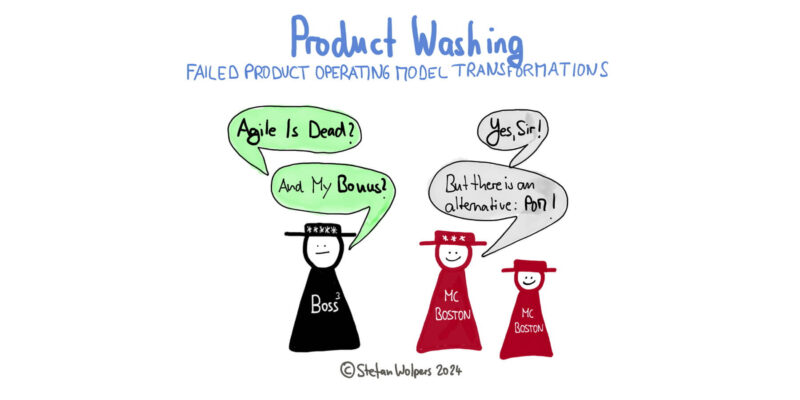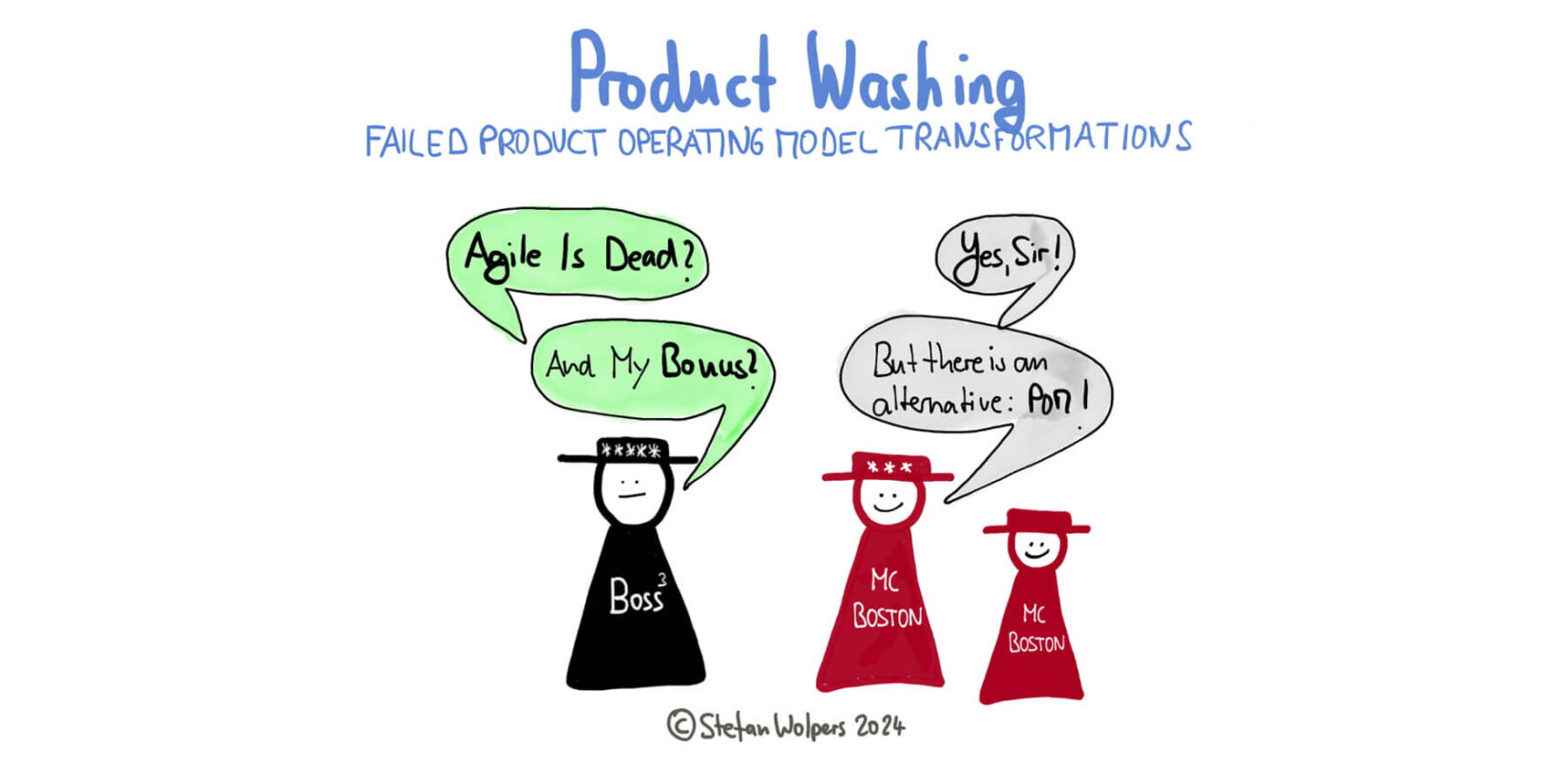TL; DR: Product Washing
By all means, the “Product Operating Model” (POM) has surged in popularity, especially among traditional organizations keen to prove their adaptability. (And, of course, among the McBostonians who, now that ”Agile” is dead, need a substitute to bill their junior consultants.) Which brings us to the problem of Product Washing.
On the surface, the product operating model promises a more customer-focused, outcome-driven approach. Empowered teams create value iteratively rather than following rigid, output-focused roadmaps. Best of all, they do so autonomously, well-aligned with the organization’s overall strategy and the possibly myriad other teams working on different initiatives. Think of SAFe done right.
Yet, for all its promise, the product operating model risks becoming another buzzword rather than an actual driver of transformation. Organizations that tout a “product-led” philosophy often do so without making the profound changes needed to live by it. This hollow adoption of product practices, or what we might call “Product Washing,” leaves companies stuck in the same old dynamics but with a new vocabulary: transformation by reprinting business cards. (Does this sound familiar?)
🎓 January 27, 2025: The Advanced Product Backlog Management Course for Just $99!
👉 Please note:
- The course includes membership in my former professional students’ brand-new Hands-on Agile community.
- The course will only be available for sign-up until February 3, 2025!
🇩🇪 Zur deutschsprachigen Version: Product Washing: Die Fallstricke einer oberflächlichen Product-Operating-Modell-Transformation.
🗞 Shall I notify you about articles like this one? Awesome! You can sign up here for the ‘Food for Agile Thought’ newsletter and join 42,000-plus subscribers.
🎓 Join Stefan in one of his upcoming Professional Scrum training classes!
What Is the Origin of Product Washing?
To understand why product washing happens, we need to investigate the motivations of stakeholders who—intentionally or not—preserve the status quo and the influence of consultancies eager to promote the product operating model as the latest cash cow.
Here’s how product washing unfolds and what it takes to implement a meaningful, sustainable product operating model:
Stakeholder Motivations: Keeping Control While Appearing “Product-Led”
Organizations may claim to adopt a product operating model, but the motivations of key stakeholders often reveal a different story. Executives, department heads, and even middle management have vested interests in preserving control resources, project timelines, and strategic decisions.
Here’s how these motivations often block authentic POM adoption:
- Protecting Established Power Structures: The product operating model fundamentally shifts decision-making to those closest to the customer and the technology—cross-functional teams that own their outcomes. However, this threatens the traditional hierarchy where C-suite and senior leaders control what gets built, when, and how. Reluctant to relinquish this power, stakeholders may advocate for the new approach rhetorically but resist implementing the autonomy that defines it. As a result, decisions remain centralized, and teams operate under tight directives rather than genuinely owning their work.
- Budget Control and Predictability: Executives accustomed to annual budgets, strict KPIs, and predictable outputs often view the product operating model as threatening the predictability they value. POM requires flexibility, room for experimentation, and a tolerance for short-term uncertainty to achieve long-term outcomes. However, maintaining predictable, centralized budget controls often comes at the cost of team empowerment, likely reducing the approach to a new coat of paint on the same project-based, budget-driven model.
- Fear of Accountability Shifts: A genuine POM shifts accountability to teams, who are responsible not just for shipping features but for delivering business results. This shift is uncomfortable for leaders who measure success by project completion rather than customer impact. These stakeholders may be wary of setting clear, outcome-driven goals, preferring to manage by tracking tasks or features completed—an approach that undercuts the entire product model ethos, but is much simpler to implement and follow through, not to mention classic incentives still linked to the old way of working.
External Consultancies: POM as a Revenue Stream
Enter the consulting giants McBoston and others. These firms have seized on the product operating model as the “next big thing” in corporate transformation, marketing it as a solution for every organization, regardless of context. Simultaneously, this approach is necessary if you want to bill junior consultants for senior consultant rates.
This external influence often distorts POM adoption in several ways:
- One-Size-Fits-All Approach: Consultancies often sell POM as a turnkey solution, ignoring each client’s unique culture, readiness, or needs. They focus on replicable templates and processes over context-sensitive transformation. This leads companies to mimic the structures of successful product companies without understanding or building the cultural foundations that make POM work. When external consultants push a model without regard for an organization’s maturity or constraints, POM becomes another misaligned framework destined to fail.
- Emphasis on Quick Wins Over Sustainable Change: Consultancies are incentivized to deliver visible, short-term results to justify their fees and retain clients. This necessity leads them to prioritize low-hanging fruit—creating “product teams,” renaming roles, or implementing surface-level changes—rather than addressing the fundamental cultural shifts the product operating model requires. These cosmetic changes provide the illusion of progress without actually enabling empowered, outcome-driven teams.
- Continued Dependence on Consulting: When consultancies position themselves as the experts and orchestrators of transformation, they often retain decision-making power. This dependency is counter to POM’s principle of empowering internal teams. By embedding consultancies into core decisions, organizations bypass their own people’s input and miss opportunities to cultivate product leadership from within. The result? An organization that looks product-driven from the outside but still leans on consultants for direction.
Anti-Patterns of a Hollow Product Operating Model Transformation
The signs of a superficial or misguided product operating model implementation — classic “product washing” — are often straightforward, yet they persist in many organizations. Here are the most common anti-patterns, along with their implications:
- Surface-Level Structural Changes: To signal alignment with the product operating model, many companies reorganize teams, rename departments, or create “product-focused” titles but fail to provide the necessary empowerment or accountability. They add layers and labels without shifting the underlying culture or processes. This approach leads to a “feature factory” where teams are busy delivering outputs but are not genuinely accountable for customer outcomes.
- Renaming Project Managers and Business Analysts as Product Managers: A particularly insidious example of product washing is rebranding existing project roles as “product managers” without redefining their roles or responsibilities. These “product managers” are probably still judged by delivery timelines and feature completion rather than the impact on customer experience or business goals. This perpetuates a task-oriented mindset incompatible with true product thinking, leaving organizations stuck in project-based thinking with new titles.
- Token Autonomy and Faux Empowerment: In a product-led organization, teams have genuine autonomy, including decision-making authority and accountability for outcomes. However, this autonomy may be only skin-deep in many failed product operating model implementations. Teams are empowered in name but restricted by top-down directives, rigid roadmaps, and lack of access to the data, funds, or tools they need to make meaningful decisions. Faux empowerment is not merely a recipe for frustration, as teams are expected to “own” outcomes without real agency. It is also a genuine sign of product washing.
- Metrics Without Meaning: Many organizations applying the product operating model seem to continue using traditional metrics like feature velocity or on-time delivery, which gauge activity rather than value. Accurate product-led metrics focus on outcomes—customer satisfaction, usage, retention, and revenue impact. Yet, because outcomes are more challenging to quantify and take longer to realize, probably outside the tenure of a responsible individual, managers may advocate using familiar but meaningless metrics, giving the organization the illusion of success, likely without genuine progress but in alignment with existing bonus systems.
Steps Toward a Genuine Product Operating Model Transformation
Avoiding product washing requires organizations to go beyond labels and create conditions where proper product-led practices can thrive. Here’s what it takes:
- Establish True Leadership Alignment on Product Goals: Leadership must buy into the principles of the product operating model beyond appearances or quick wins. The CEO, CPO, CTO, and other leaders must visibly support the shift to outcome-driven work, even if it means relinquishing some control. This may require fundamental shifts in determining budgets, priorities, and strategic initiatives. Leaders must demonstrate commitment by promoting experimentation, creating a failure culture, valuing customer impact, and prioritizing long-term goals over short-term metrics.
- Build Competency, Not Dependency: Instead of relying on consultants to drive the transformation, focus on building internal expertise. Train product managers, designers, and engineers in customer-centric thinking, data literacy, and business acumen. This investment will take (much) more time but, consequently, allows the organization to make informed decisions independently and empowers teams to drive their own product success without an external crutch.
- Shift Metrics to Focus on Outcomes; Adapt Bonus Systems: Meaningful metrics are critical. Move away from delivery-based metrics like feature count or project completion toward outcome-focused metrics that reflect customer value and business impact. Customer retention, satisfaction, and usage are far more telling than feature velocity. This shift in measurement reinforces a culture focused on impact rather than activity. Moreover, ensure that the required change in metrics is reflected in everyone’s bonus structure.
- Start Small, Learn, and Scale Intentionally: Instead of a top-down, all-in POM rollout, begin with pilot teams that are genuinely empowered, accountable, and aligned with a clear product vision. Gather insights from these initial teams and iterate on what works and what doesn’t. Gradually scaling the product operating model adaptation helps avoid overcommitment to a rigid model and provides opportunities to adjust based on actual outcomes and feedback.
- Commit to a Culture of Learning and Adaptation: Product-led organizations are never static. Build mechanisms for continuous feedback from customers and internally and establish a culture where teams generally feel safe to challenge assumptions and fail in the process of creating value. This mindset of learning and iteration is the cornerstone of any successful product organization and enables lasting transformation over surface-level change.
Conclusion
The Product Operating Model’s allure is powerful, but without real commitment, it’s little more than another management fad. Product Washing—implementing POM in name only—is worse than not adopting the product operating model at all, as it breeds cynicism and disillusionment within teams. True transformation requires profound, often uncomfortable cultural shifts, accountability, and leadership.
For organizations serious about the product operating model, the journey starts with clear intent and a willingness to address uncomfortable truths. Abandon the quick wins and invest in building product expertise, real team empowerment, and an unwavering focus on outcomes. Anything less is just another rebranding exercise destined to fail or product washing.
Product Washing — Related Articles
👆 Stefan Wolpers: The Scrum Anti-Patterns Guide (Affiliate advertisement at no cost to you.)
Agile Failure Patterns in Organizations 2.0.
The Uncomfortable Truth of Scaling ‘Agile’.
The Peril of Adhering to Legacy Systems, Processes, and Practices — Scrum Anti-Patterns Taxonomy (1).
Scrum Anti-Patterns Taxonomy — The Big Picture of Why Scrum Fails?
11 Proven Stakeholder Communication Tactics during an Agile Transition
Download the Scrum Anti-Patterns Guide for free.
📅 Scrum Training Classes, Workshops, and Events
Learn more about Product Backlog anti-patterns with our Scrum training classes, workshops, and events. You can secure your seat directly by following the corresponding link in the table below:
See all upcoming classes here.
You can book your seat for the training directly by following the corresponding links to the ticket shop. If the procurement process of your organization requires a different purchasing process, please contact Berlin Product People GmbH directly.
✋ Do Not Miss Out and Learn more about Product Washing — Join the 19,000-plus Strong ‘Hands-on Agile’ Slack Community
I invite you to join the “Hands-on Agile” Slack Community and enjoy the benefits of a fast-growing, vibrant community of agile practitioners from around the world.
If you would like to join all you have to do now is provide your credentials via this Google form, and I will sign you up. By the way, it’s free.
Prepare yourself for Mastering Work Intake by studying the free Scrum Anti-Patterns Guide:






